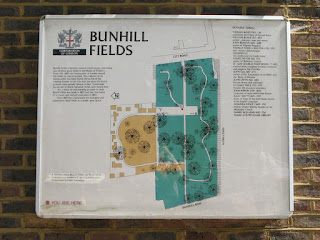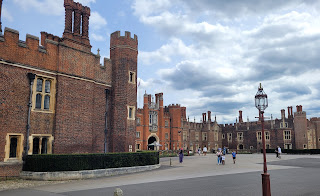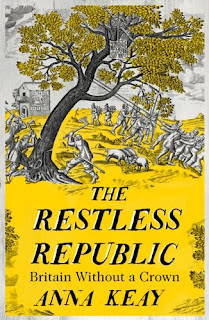London, Part Five: Memorials (and Churches)
Now with added map with locations and travel directions!
The easiest way to complete this tour is using public transport (with some walking) and I have given directions using TfL Underground/Overground/Docklands Light Railway and the bus network. If you are unfamiliar with town and the transport system, the easiest (and cheapest) way to pay is using a contactless card, Oyster Card or app - just remember to tap in and tap out at each station. You will need a tube map (free from stations or better still download an app, most of which allow you to plan journeys) and a map app such as Google Maps on your phone.
First stop is Bunhill Burial Ground, City Road EC3 - Exit 3 Old Street tube station. Bunhill was known as the hill of bones - literally bone hill; which overtime became Bunhill. Buried here are three of Oliver Cromwell's great grandsons, Lieutenant General Charles Fleetwood and Thomas Goodwin, Cromwell's chaplain. There are quite a few other famous 'residents' at Bunhill too. Much of Bunhill is fenced off, visits into the fenced off areas can be arranged - details can be found on the City of London website link above.
Now you have a choice: walk south (0.7 miles, about 15 minutes) or hop back on the Northern Line for one stop to Moorgate to
St Giles-without-Cripplegate, another location with a Cromwellian link. This was Oliver's parish church, and where he married Elizabeth Bourchier in 1620. There is a bust of Cromwell inside the church, on the north side of the tower.
A newly commissioned stained glass window commemorates the wedding
From Moorgate, travel eastbound to Liverpool Street Station (Metropolitan, Hammersmith & City or Circle Lines) then a six minute walk to
St Helen's Church, Bishops Gate. St Helen's survived both the Great Fire and the Blitz, but not the attentions of the IRA. Inside you will find a monument to Martin Bond, sometime MP and merchant adventurer. Martin had a long involvement with the London Trained Bands dating back to 1588, and was the Chief Captain of the Trained Bands at his death in 1643.
There used to be an art installation which mapped the Civil War defences of London located on Bishops Gate, sadly it is no longer there.
St John's Churchyard, Wapping High Street (0.25 mile walk from the station). The church yard is now a public park. High up on a wall is a plaque commemorating Colonel Thomas Rainsborough, the highest ranking officer to support the Levellers.
A trio of choices now, marginally quickest is a scenic walk along the Thames (1.1 miles, about 23 minutes), slightly longer is to catch the 100 bus from Wapping (Sampson Street stand T, to the Tower, then walk the final 0.3 miles), or the longest route is retrace your steps on the Overground/DLR to Tower Gateway then walking the remainder of the route. Whichever route you take your next destination is...
The Hung Drawn and Quartered pub on Great Tower Street, where there is a plaque using Pepys' observations about the execution of the regecide Major General Harrison (hence the name of the pub). As you are here, it would be a good time to take refreshment.
Suitably refreshed, walk/stagger northwards along Great Tower Street to Monument station to catch the Northern Line southbound, to Borough.
A short walk down the High Street and you'll find Southwark Police Station, where you will find the only memorial of the civil war defences of London, Stones End fort. A plaque marks the spot. Only it isn't the right spot, the real spot is over 200 metres south of the plaque.
Return to Borough station, catch the Northern line southbound to Elephant and Castle and get on the Bakerloo Line to Charing Cross. From Charing Cross it is a 13 minute walk to St James's Square.
Here you need to find Chatham House, on which you will find a plaque commemorating the location of the house of Henry Jermyn, Earl of St Albans. Jermyn was described as a 'favourite of the Queen' and there was gossip that he fathered Charles II, so 'yes' - that sort of favourite.
Retrace your steps to Charing Cross, travel south (Bakerloo or Northern Line) to Embankment where you need to change to the District Line (to Wimbledon) westbound alighting at Putney Bridge.
Final stop is St Mary's Church, Putney. Location of the Putney debates. There is a small permanent exhibition devoted to the debates and a dedicated website.
If you really get bitten by the 'obscure places in London that have a Civil War connection' bug then you really do need to invest in a copy of "Civil War In London A Military History of London Under Charles I and Oliver Cromwell" by David Flintham, Helion & Co.. Towards the back of the book is a London Gazeteer which lists oodles of places, and a couple more that deserve their place in my tour.
Lots more for the London Civil War tourist can be found here.
Postcodes for SatNavs/mapping apps, and closest TfL stations
Bunhill Burial Ground, City Road EC1Y 2BG Old Street Station (exit 3)
St Giles-without-Cripplegate, Fore Street EC2Y 8DA Moorgate
St Helen's, Bishops Gate EC3A 6AT Liverpool Street
St John's Churchyard Wapping High Street E1W 2PL Wapping Overground
Hung Drawn and Quartered, Great Tower Street EC3R 5AQ Tower Hill
Southwark Police Station, Borough High Street SE1 1JL Borough
Chatham House, 10 St James's Square, SW1Y 4LE Charing Cross
St Mary's Church, Putney SW15 1SN Putney Bridge
If you enjoyed reading this, or any of the other posts, please consider supporting the blog.
Thanks.





















Can you slow down please? I'm running out of time to fit all this visiting in. ;-)
ReplyDeleteIt's yonks since I wandered around Bunhill cemetary. The HAC is virtually next door too.
It's almost painting season at Château KeepYourPowderDry, so there may only be a couple more travelogue entries this year allowing you to catch up before next season's fixture list. ;-)
DeleteIs HAC worth a visit?
Superb, than you for sharing. Absolutely fascinating!
DeleteMany thanks
DeleteI've only been inside the HAC building once, for a rather boozy corporate junket. It doesn't look like they have open hours for visitors judging by the website.
ReplyDeleteA shame. Thanks for the info
DeleteStored this one for a suitable visit to London... excellent..
ReplyDeleteGlad you enjoyed it
DeleteSome great spots there - great resource for the next London trip! Thanks. :)
ReplyDeleteYou are welcome. Bond's memorial is my favourite.
Delete